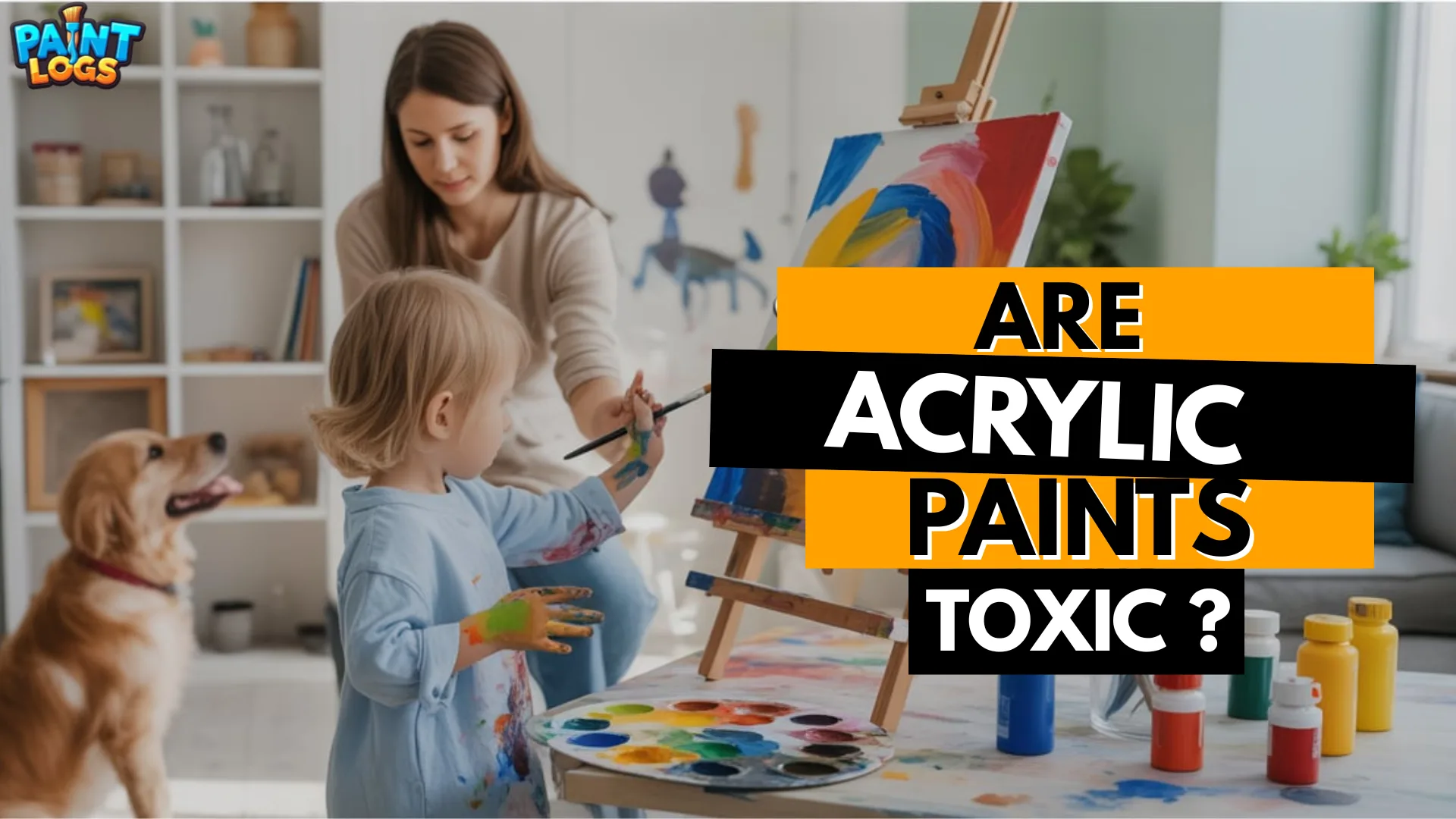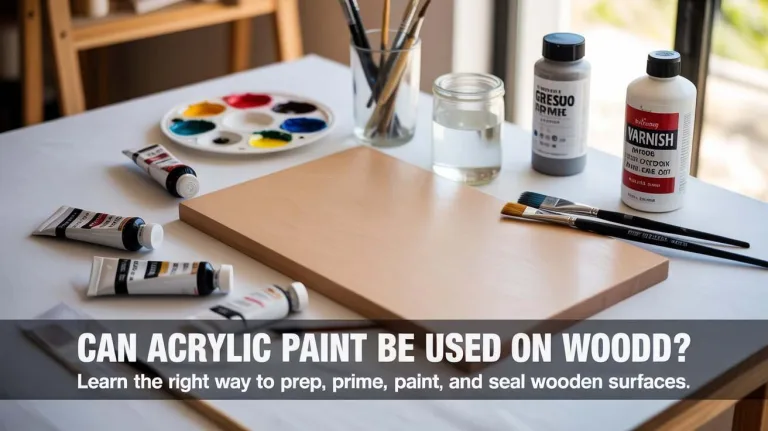Acrylic paints are generally safe and labeled non-toxic (AP seal) when used as directed. They don’t release strong fumes, are water-based, and once dry form a stable film that is safe to touch. Risks come from certain pigments (like cadmiums), sanding or spraying dried paint, and accidental ingestion by kids or pets. Always check the label: AP = safe, CL = cautionary use only.
Introduction
Walk into any art store and you’ll see rows of brightly colored acrylic paints labeled with mysterious symbols—AP, CL, cadmium hues, non-toxic claims. For beginners and even seasoned artists, the question often lingers: Are acrylic paints actually toxic?
The answer isn’t as black-and-white as marketing labels suggest. Most acrylic paints today are water-based and designed to be safe for everyday use. Yet, the fine print matters. Certain pigments carry health warnings, sanding or spraying can create hazards, and not all paints are appropriate for children, pets, or pregnancy.
This guide clears up the confusion. You’ll learn what “non-toxic” really means, how to identify safe labels, what risks exist for humans and animals, and the simple habits that keep your studio a safe, creative space.
By the end, you’ll know exactly which paints to buy, how to use them responsibly, and where the true dangers (and myths) lie.
What “Non-Toxic” Really Means
When a tube says “non-toxic,” it doesn’t mean you can eat it or let toddlers chew brushes. Instead, it refers to safety standards set by art material testing bodies.
- AP Seal (Approved Product): Safe for normal use in studios, schools, and homes. These paints are cleared of both short- and long-term health hazards in typical conditions.
- CL Seal (Cautionary Labeling): Indicates that certain ingredients (like cadmium pigments) require extra care. These are not suitable for children and should be used only by informed adults.
Key takeaway: The seal tells you more about safety than the marketing claims on the front of the tube.
Are Water-Based Acrylic Paints Toxic?
Most artist acrylics today are water-based, which makes them far less hazardous than oil paints or solvent-heavy mediums. Water-based acrylics have:
- Low odor and fumes compared to turpentine or mineral spirits.
- Quick cleanup with soap and water.
- Safer indoor use, provided you ventilate your space.
However, not every water-based paint is automatically safe. Some contain pigments that still carry cautionary labels. Always read the back of the tube or jar before buying.
Are Liquitex and GOLDEN Acrylic Paints Non-Toxic?
Two of the most trusted brands in the art world—Liquitex and GOLDEN—publish clear safety information on every product.
- Liquitex: Many of their colors, including cadmium-free ranges, carry the AP seal. These are safe for most general use. A few specialty pigments, however, are labeled with CL.
- GOLDEN: Similar to Liquitex, most colors are AP-certified. But some traditional pigments (like cadmiums) include cautionary labels.
Rule of thumb: If you stick to AP-labeled products from either brand, you’ll be working with paints considered safe for studio use and indoor painting.
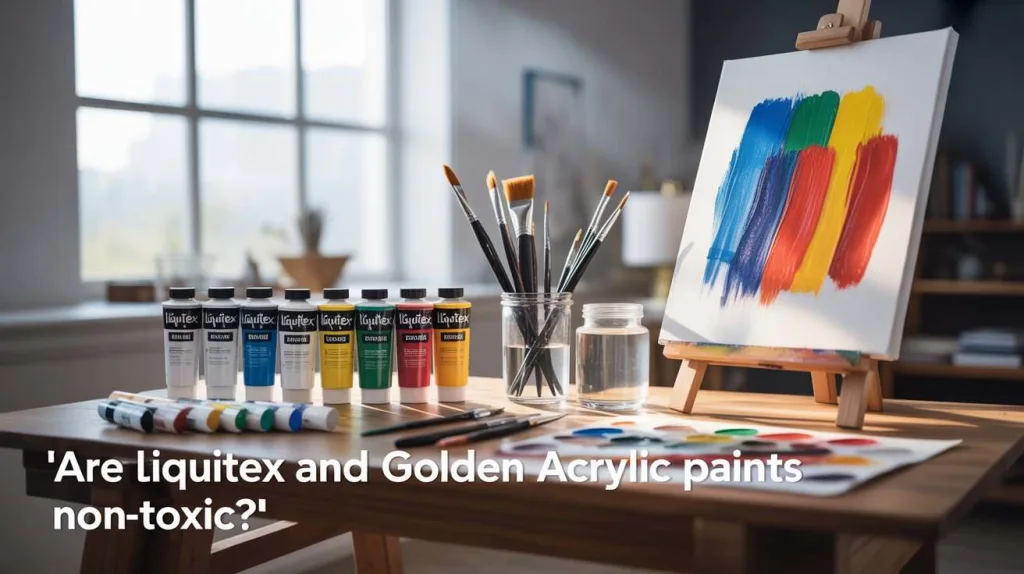
Are Cadmium Acrylic Paints Toxic?
Cadmium pigments are famous for their brilliant reds, oranges, and yellows. They’re also the main reason some acrylics carry a CL (Cautionary Label).
- Normal brush use: Low risk. Once applied to canvas and left to dry, cadmium paint isn’t absorbed through the skin.
- Spraying, sanding, or burning: High risk. This can release toxic particles or fumes.
- Cadmium-free hues: Many brands now offer safe alternatives that mimic the look without the hazard.
Bottom line: If you love cadmium colors, use them carefully—brush only, good ventilation, and never sand or spray.
Is Acrylic Paint Toxic After It Dries?
Once acrylic paint dries, it forms a flexible plastic film. In this state, it’s considered inert and safe to touch.
Where risk returns is when you disturb that film: sanding, cutting, or heating dried acrylic can create dust or fumes. These particles aren’t safe to breathe in, so always wear protection or avoid sanding altogether.
For finished artwork, dry acrylic paint is safe to handle and display.
Is Acrylic Paint Toxic if Swallowed or Inhaled?
- Swallowed: Small accidental amounts of non-toxic acrylic (like a child getting a dab on their fingers) usually cause mild stomach upset at worst. Still, no paint is meant to be eaten, so wash hands thoroughly and supervise kids.
- Inhaled: Brushing acrylics rarely produces dangerous vapors. The risk comes with spraying or airbrushing, where fine particles can lodge in your lungs. Always wear a mask and ventilate if you use acrylics this way.
Tip: Treat your studio like a kitchen—if you wouldn’t eat it, don’t let it near your mouth.
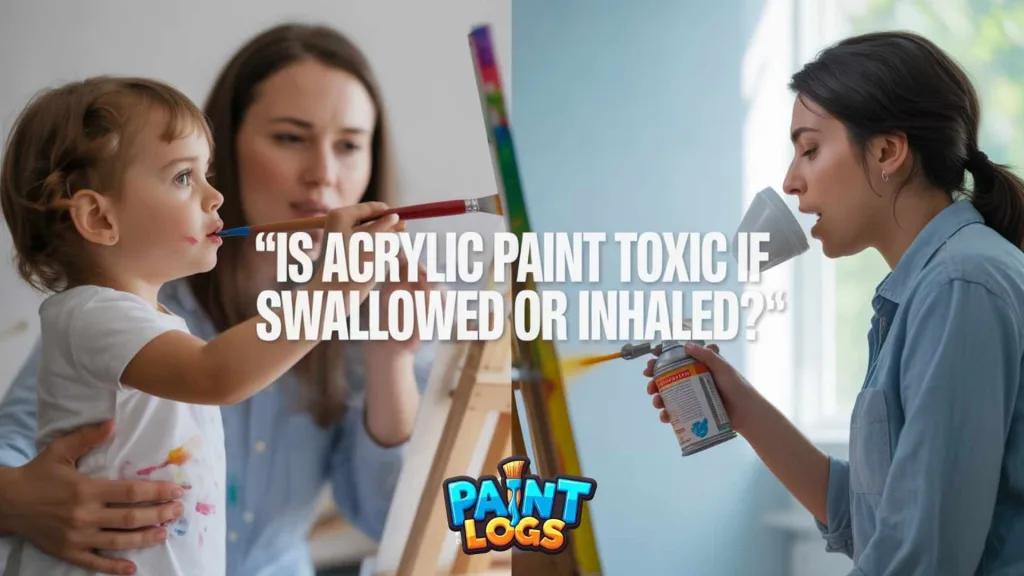
Are Acrylic Paints Safe for Kids and Toddlers?
Acrylic paints can be safe for children, but only when they carry the AP (Approved Product) seal. These paints have been tested and cleared for classroom and hobby use.
- Yes: Water-based AP-labeled paints, designed for schools and home projects.
- No: CL-labeled paints, especially those containing cadmium or other heavy metals.
Young children should never use artist-grade acrylics unsupervised. Remind them not to put brushes in their mouths, wash hands afterward, and keep sessions short to avoid messy accidents.

Acrylic Paints Are Toxic to Pets or Not?
Cats and dogs are naturally curious—and sometimes clumsy—around your easel. The good news is that most AP-labeled acrylics are considered low risk if they get on fur or paws. The problem is when pets lick wet paint. This can cause mild stomach upset, drooling, or vomiting.
- Dogs & cats: Clean paws quickly with mild soap and water.
- Birds: Extremely sensitive to fumes and airborne particles. Never spray acrylics around them.
- Prevention: Keep pets out of your studio when you’re working, and store paint containers securely.
Is Acrylic Paint Harmful for Pregnancy?
Many pregnant artists continue working with acrylics because they’re water-based and don’t release strong solvent fumes. Still, a few extra steps add peace of mind:
- Choose AP-labeled products.
- Ventilate your space. Open windows or use a small fan.
- Avoid spraying or sanding. These create particles you don’t want to inhale.
- Use gloves if you have sensitive skin or cuts on your hands.
When in doubt, discuss specific paint labels with your doctor. With these precautions, acrylics remain one of the safest mediums to use during pregnancy.
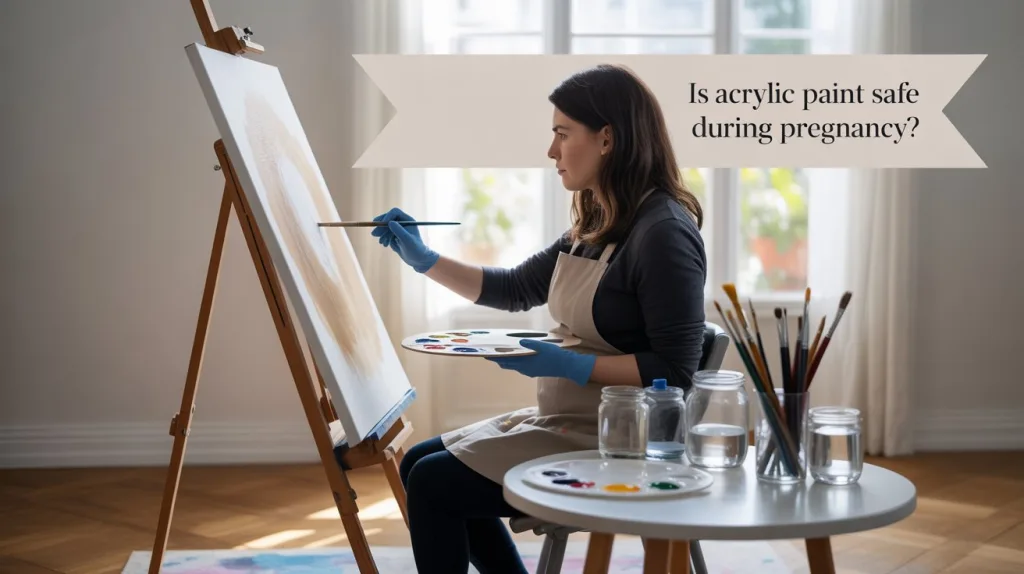
Quick Safety Checklist for Artists
Keep this simple list posted in your studio as a daily reminder:
- Check labels: Look for AP vs CL before using any paint.
- Ventilate: Open a window or use a fan while painting.
- Wash hands: No snacks or drinks at the easel, and always clean up afterward.
- Protect yourself: Never sand or spray without a proper mask and ventilation.
- Protect others: Keep kids and pets away from wet paint areas.
- Store safely: Seal lids tightly and keep paints out of reach.
- Dispose properly: Don’t pour paint water or sludge down household drains.
Common Scenarios and What to Do
- Kids with paint on hands: Wash gently with soap and water. Avoid harsh scrubbing that could irritate skin.
- Pet stepped in paint: Rinse paws quickly, dry thoroughly, and monitor for licking or upset stomach.
- You want cadmium colors: Use brush-only techniques, avoid spraying or sanding, and consider cadmium-free “hue” alternatives.
- Need to sand a painting: Wear a respirator, wet-sand to reduce dust, or skip sanding entirely.
Conclusion
Acrylic paints are among the safest and most versatile mediums available today. With water-based formulas, low fumes, and wide accessibility, they’re an excellent choice for artists at every level. Still, safety depends on awareness:
- Choose AP-labeled paints for everyday work, kids, and classrooms.
- Treat CL-labeled paints, especially cadmium colors, with extra care.
- Ventilate your space, wash your hands, and never sand or spray without protection.
- Keep kids, pets, and food far from your easel.
Used responsibly, acrylic paints are not only safe but also empowering—they allow you to create indoors, experiment with vibrant colors, and explore techniques without harsh solvents.
The real secret: safety isn’t about avoiding acrylics; it’s about respecting them. With a few simple habits, you can enjoy the full creative freedom of acrylic painting while keeping yourself, your family, and your studio environment healthy.
FAQs
Are acrylic paints toxic?
Most acrylics labeled AP are non-toxic in normal use. Risks increase with CL-labeled pigments, spraying, sanding, or ingestion.
Do acrylic paints give off toxic fumes?
Brushed acrylics give off minimal fumes. Spraying or overheating them can release harmful particles.
What are bad things about acrylic paint?
They dry quickly (harder to blend), may contain pigments like cadmium, and sanding dried films can create harmful dust.
Is acrylic paint safe to use indoors?
Yes, with good ventilation. Avoid spraying without protective equipment and filtration.
How to know if acrylic is non-toxic?
Look for the AP seal. CL-labeled products require caution and are not child-safe.
Are Liquitex acrylic paints non-toxic?
Many Liquitex paints are AP-labeled, but some pigments have caution labels.
Are GOLDEN acrylic paints toxic?
Most are AP-labeled, but certain colors require caution. Always read the label.
Are cadmium acrylic paints dangerous?
Only if sanded, sprayed, or overheated. For safety, use cadmium-free “hue” alternatives.
Is acrylic paint toxic after it dries?
Dry acrylic films are safe to touch, but sanding can produce harmful dust.
Is acrylic paint toxic to cats or dogs?
Usually low risk in small amounts. Ingestion may cause mild stomach upset.
Is water-based acrylic paint non-toxic?
Often yes, but only when labeled AP. Always confirm before use.
Are acrylic paints safe for toddlers?
Yes, if AP-labeled and supervised. Avoid all CL products.
Are acrylic paints toxic to breathe in?
Brushing is safe; spraying creates fine particles that should not be inhaled.

